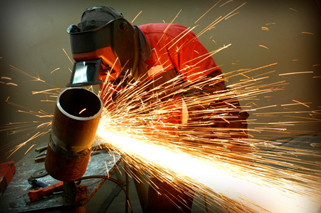Hot Work Toolbox Talk
Hot Work
When you weld, cut or grind, the potential for accidents is significant, so it's crucial to be cautious. Wear your personal protective equipment (PPE), and follow the established safety rules.
Program Scope
Hot Work; includes but not limited to any work that involves operations including cutting, welding, Thermit welding, brazing, soldering, grinding, thermal spraying, thawing pipe, installation of torch-applied roof systems or any other similar activity. The following operations do not require a Hot Work Permit; Fixed Grinding Wheels, Electric Soldering Irons, Heat Guns, Matches / Lighters, Process Equipment (e.g. furnaces, ovens, hot water tanks, boilers, etc.) and Lab related activities including Bunsen Burners, Hot Plates, Propane/Butane Torches (equal to or less than 15oz)
General Hot Work Safety Rules
Whenever possible, move welding to an Approved Designated Area, a permanent location designed or approved for hot work operations to be performed regularly.
If doing Hot Work is performed outside a Designated Area:
- Complete the FM Global Hot Work Permit and maintain the 35 Foot-Rule;
-
Keep combustible materials 35ft from the point of operation,
- Or protect combustibles by a listed or approved welding curtain, welding blanket, welding pad, or equivalent.
- Ensure a fire extinguisher is readily available and accessible.
-
- If the 35 Foot-Rule cannot be maintained, a Fire Watch must be present.
- A Fire Watch is an employee who is trained in hot work safety and monitors the hot work area for changing conditions and watches for fires and extinguishes fire if possible.
- The fire watch is someone other than Hot Work Operator. A fire watch shall be maintained for at least 1 hour after completion of hot work operations in order to detect and extinguish smoldering fires.
Wear appropriate personal protective equipment, such as face shield, leather welder's vest, and gauntlet gloves. Use cotton or denim clothing.
Make sure there is sufficient general ventilation. Where welding fumes and gases can accumulate, use local exhaust ventilation to remove the contaminants.
Inspect equipment for loose connections, bare wires or cables before operating. Make sure the machinery is properly grounded.
All units must be equipped with back-flow prevention and flash back arrestors.
Following proper use and storage procedures.
University Program
For any questions regarding Hot Work, or for information regarding Cornell University’s requirements for Hot Work, please consult the University Program found at Hot Work and Welding Safety.


